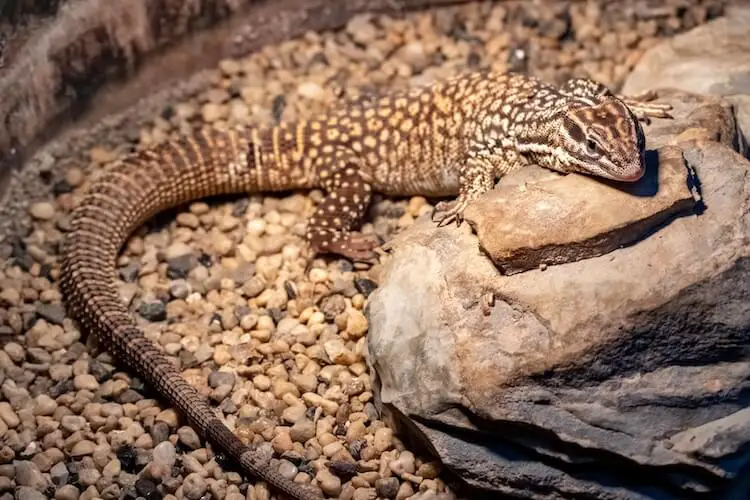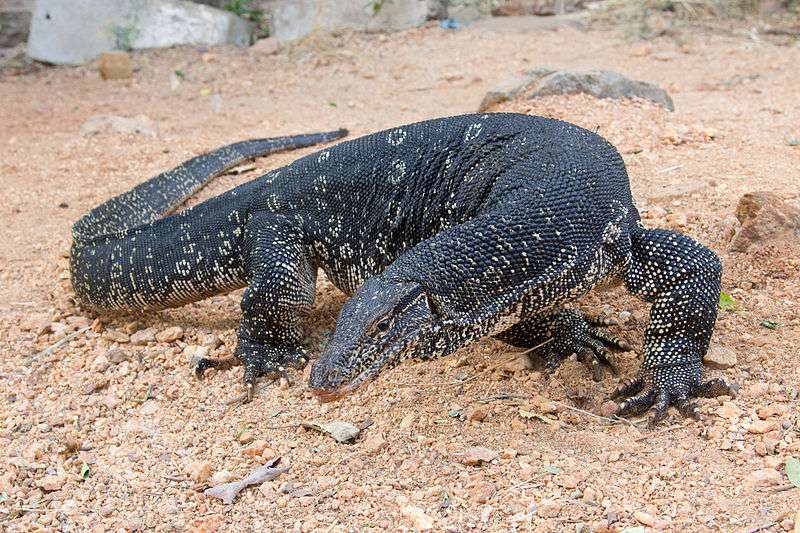
Description
Scientific name: Varanus beccarii
Life span: Up to 10+ years
Black tree monitors are distinctive kinds of monitor lizards that have a primitive appearance. They possess slim bodies and lengthy tails that account for two-thirds of their whole body length. Male Black tree monitor lizards may grow up to a total length of 90–120 cm (including tail) and are somewhat bigger than females. The hatchlings and juveniles of this species are dark-grey in color having yellow-green spots that are prominent on their backs. They lose their colored spots and become fully black when they mature. In general, they have good adaptations for living in branches. Its tail serves as a prehensile to keep the animal stable in the trees. The tail is employed primarily for this function, as the animal does not display the protective tail-lashing response found in other species. Black tree monitor twists its tails around and grasps objects because its tail is prehensile. To defend themselves, these monitors precisely whirl around and flap their tails.
Native Region/Habitat
Black tree monitors are endemic to Aru Island of Indonesia. Due to its arboreal lifestyle, it primarily lives in wet woods and wetlands. They are found in mangrove wetlands and tropical woods. They live in trees and spend the majority of their lifetime above ground.

Behavior
These monitors live alone and lack social interaction and territoriality. Bipedal ritual (upright walking) has been spotted in the woods during the mating season. Male monitors are tolerant of females inside their territory. The eggs are buried or kept by females in a warm environment in which they can incubate and hatch. Usually, they construct their nests in rotting logs, termites mound, and tree holes. Female monitors guard their newborns for a short time before letting them go. In the wild, these monitors are rumored to be anxious and very tense; if frightened, they will prefer to run away. If these monitors are handled improperly, they may bite, scratch, and then urinate on the attacker. Black tree monitors fight with each other by standing on their back legs. Black Trees are clever creatures that make them excellent pets but they are not good for everyone. Baby monitors typically will not bite, but until your monitor becomes attached to you, you must refrain from holding it too much.
Care As a pet/In captivity
They require moderate care. When they reach adulthood, they will require a very large, specifically designed habitat. For six to eight months of their lives, the juvenile monitor can be housed in an enclosure similar to an Exo Terra 18″ x 18″ x 24″. When the black monitor will grow in size and get mature it will need the Exo Terra big 36″ x 18″ x 36″. The difficulty in maintaining the proper humidity makes screen casings for monitors unsuitable.
Black Trees have the propensity to damage themselves by bumping into the glass. To avoid this add branches or structures for climbing on when creating an enclosure for these monitors. They also prefer broad logs or high shelves. They prefer not to always be forced to hold on to anything vertical. Since they are tropical species, the cage must include both a warmer area for basking and a cooler area for them to regulate the temperature of their body. It is recommended to have a 95–100 degree temperature for sunbathing.
Table





